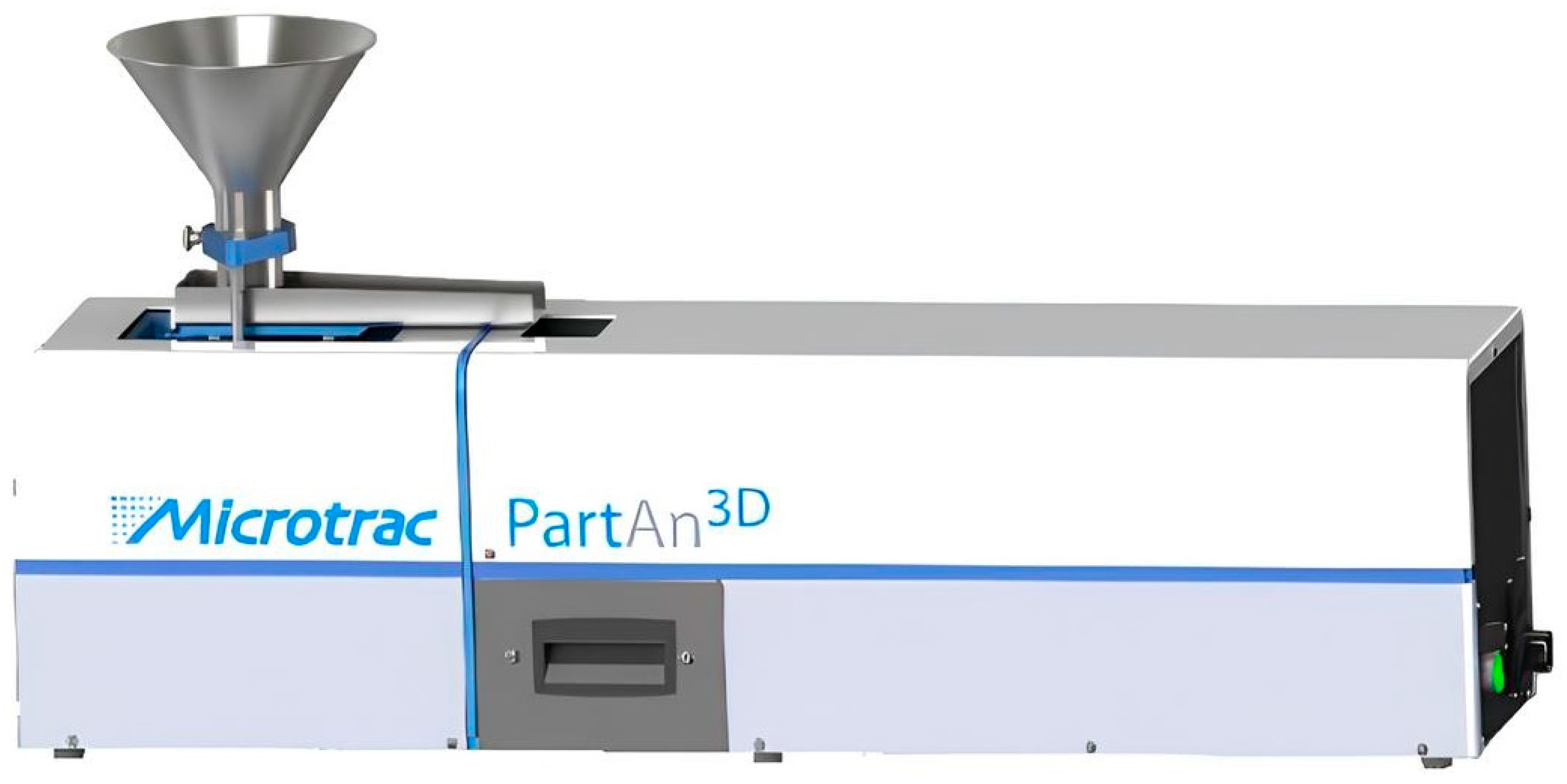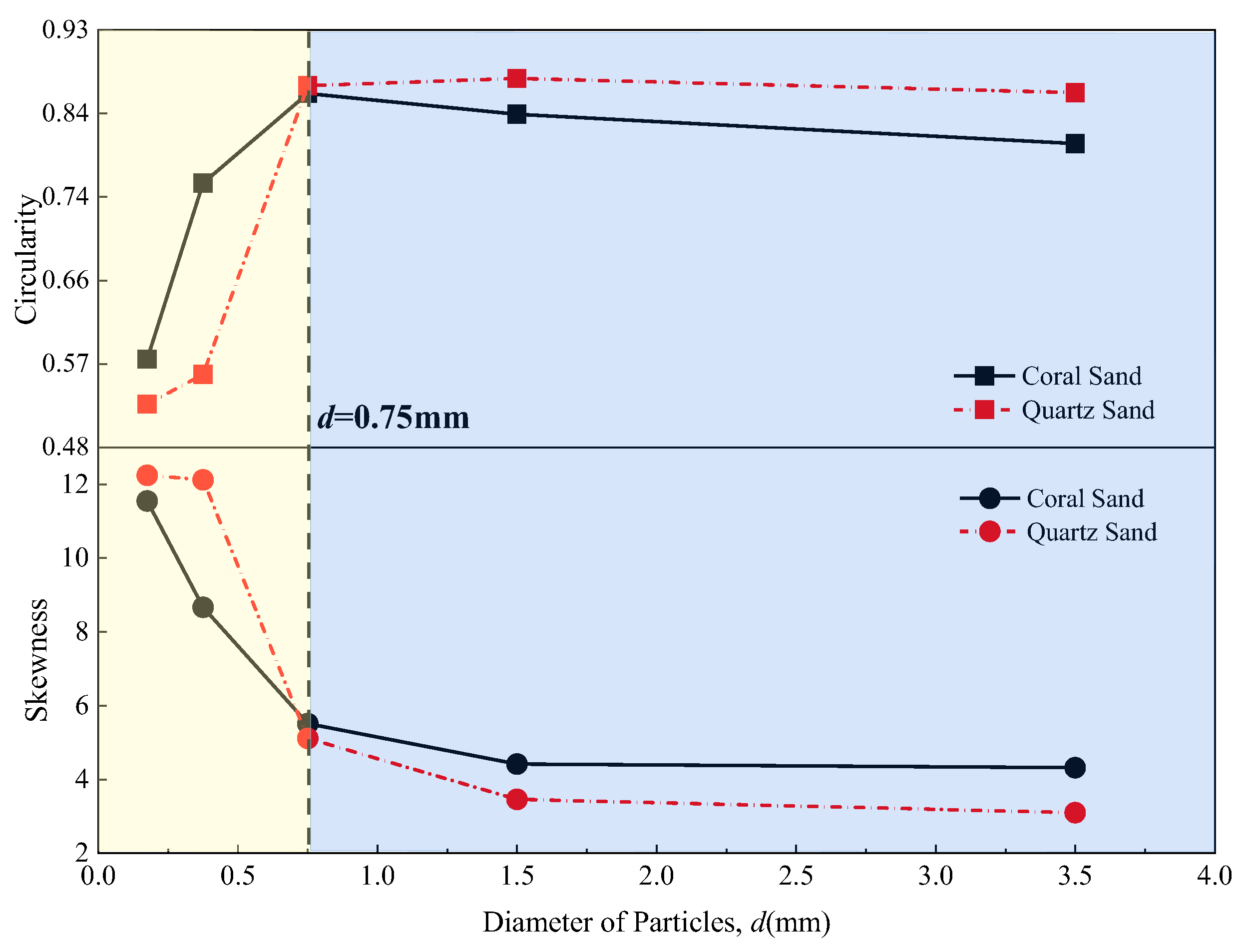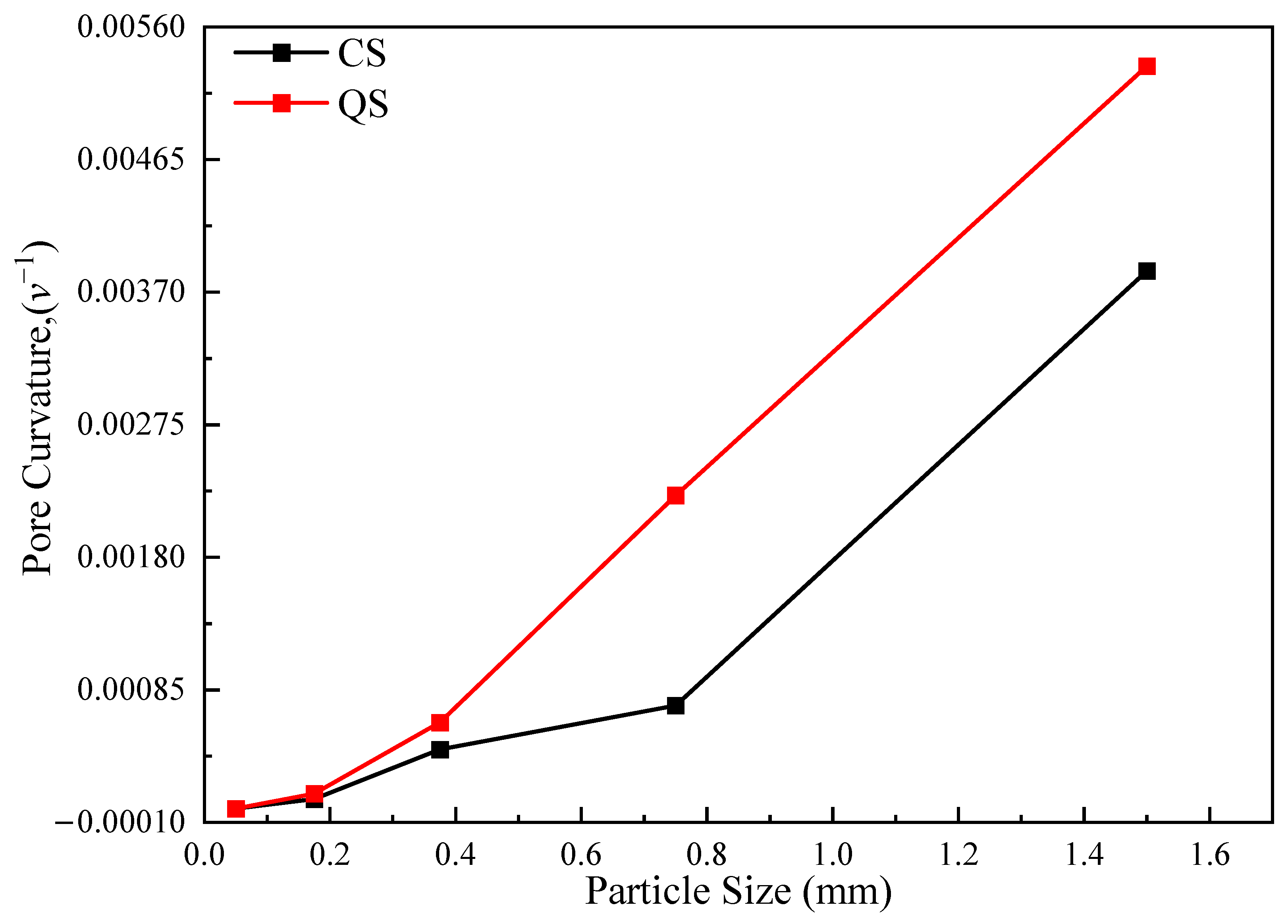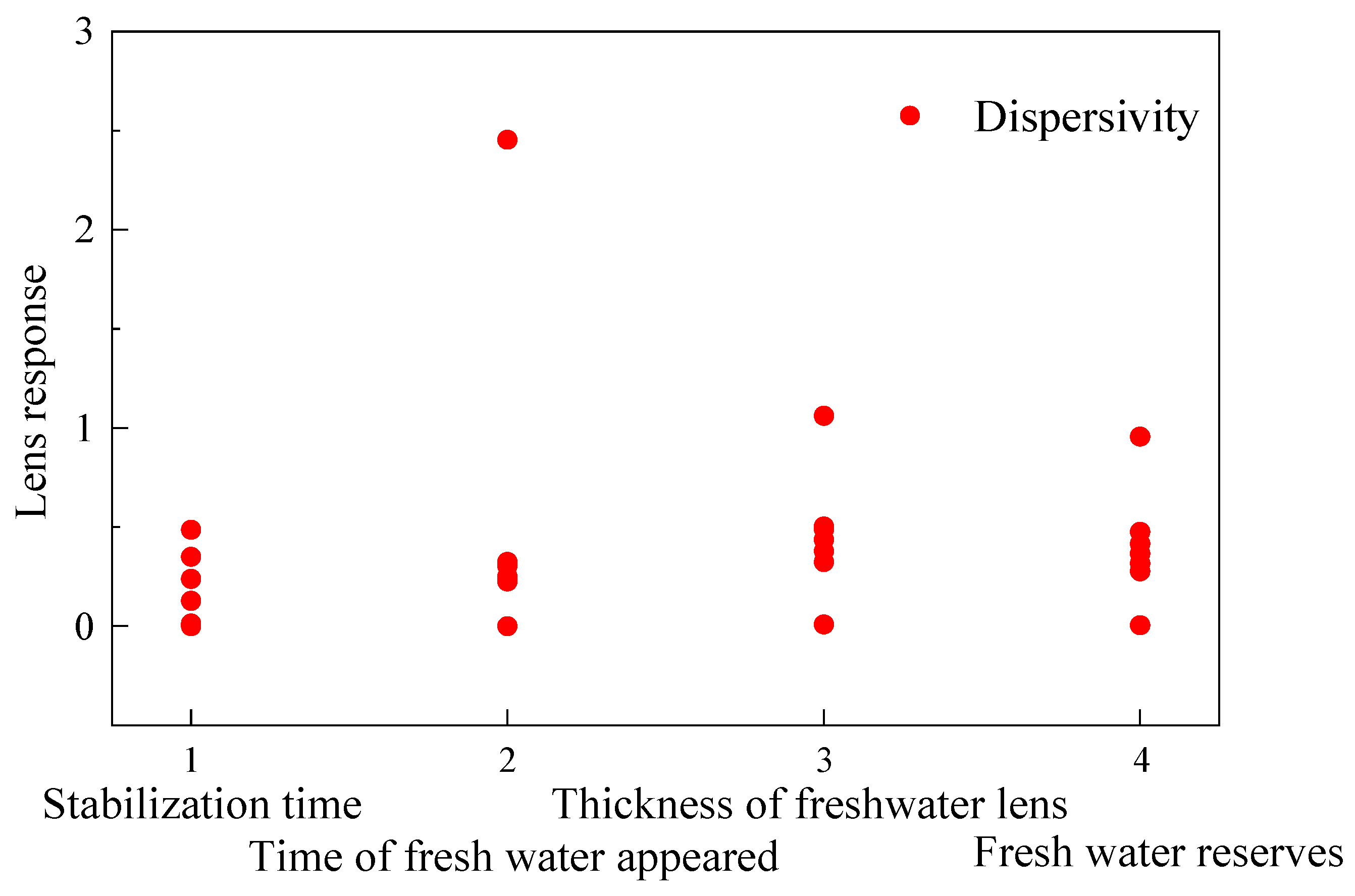Dispersion Mechanism and Sensitivity Analysis of Coral Sand
Abstract
1. Introduction
2. The Study Area and Sample Characteristics
2.1. The Study Area
2.2. Sample Characteristics
2.3. Sample Preparation
- (1)
- Pre-wetting: Before filling the sample, add 5% of the dry sand’s mass to freshwater and mix it with the dry sand. Mix thoroughly to achieve a slightly moist state. This reduces the particle segregation during filling.
- (2)
- Layered filling: Divide the required sand volume into five equal layers based on the height of the sample cylinder. Pour the first layer of moist sand evenly into the sample cylinder.
- (3)
- Compaction within layers: Gently tap the side walls of the sample cylinder with a rubber hammer until the top surface of the sand layer reaches the predefined layer height mark. The tapping force must be consistent to avoid disturbing the already compacted layers.
- (4)
- Interlayer treatment: Before adding the next layer of sand, use a scraper to roughen the surface of the compacted sand layer, enhancing the interlayer bonding.
- (5)
- Repeat filling: Repeat steps 2 to 4 to sequentially fill and compact the remaining sand layers until the target sample height is reached.
3. The Experimental Methodology
3.1. The One-Dimensional Dispersion Test
3.2. The Molecular Diffusion Test
3.3. The Particle Morphology Analysis Test
4. Characterization of Granular Properties
4.1. The Particle Contact Surface Properties
4.2. Particle Contact Angle Characterization
4.3. Particle Morphology Characteristics
5. Analysis of the Dispersion Characteristics
5.1. Analysis of the Coefficient of Dispersion (COD)
5.2. Molecular Diffusion
5.3. COD Conversion
6. Modeling and Sensitivity Analysis
6.1. Basic Information on the Model
- (1)
- The variable-density water flow formula was based on mass conservation and Darcy’s law:
- (2)
- The solute transport formula is as follows:
6.2. Parameter Sensitivity Analysis Method
6.3. Sensitivity Analysis
6.3.1. The Freshwater Lens Response Patterns
6.3.2. Parameter Sensitivity Analysis Results
7. Conclusions
- (1)
- Based on comprehensive morphological characterization using PartAn3D, the zeta potential, the particle contact angle, and other microscopic experiments, the main reasons for the difference in dispersion between coral sand and quartz sand (QS) were first revealed to be the difference in the roughness (Ψ), roundness (Φ), surface hydrophilicity (C), and particle charge (Z) of the particles. Additionally, it was found that the action of these four factors on the dispersive properties varies with particle size.
- (2)
- A transformation model for the coefficient of dispersion (COD) of coral sand and quartz sand was developed from a microscopic perspective, achieving a high degree of accuracy (R2 > 0.99). This model overcomes the limitations of the traditional empirical formulas and can be directly integrated into numerical simulations of island reef engineering, thereby reducing the errors in freshwater lens reservoir assessments and enabling more precise predictions for resource development.
- (3)
- The results of the GMS numerical simulation quantitatively reveal the spatial and temporal control effects of the COD on the formation and evolution of freshwater lenses in the subsurface of coral reefs. The factors affecting the freshwater lens response, ranked by sensitivity, are as follows: freshwater appearance time, freshwater body thickness, freshwater reserve, and lens stabilization time. This sensitivity ranking provides a basis for prioritizing the management of freshwater development impacts on coral reefs.
Author Contributions
Funding
Data Availability Statement
Conflicts of Interest
References
- Sheng, C.; Jiao, J.J.; Xu, H.; Liu, Y.; Luo, X. Influence of Land Reclamation on Fresh Groundwater Lenses in Oceanic Islands: Laboratory and Numerical Validation. Water Resour. Res. 2021, 57, e2021WR030238. [Google Scholar] [CrossRef]
- Tang, Y.; Yan, M.; Wang, X.; Lu, C.; Luo, J. Analytical Solutions for Fresh Groundwater Lenses in Small Strip Islands with Spatially Variable Recharge. Water Resour. Res. 2021, 57, e2020WR029497. [Google Scholar] [CrossRef]
- Cui, X.; Qu, R.; Hu, M. Response of Freshwater Lenses to Precipitation and Tides. J. Mar. Sci. Eng. 2025, 13, 738. [Google Scholar] [CrossRef]
- Tang, Y.; Lu, C.; Luo, J. Optimizing Groundwater Pumping in Small Island Groundwater Lenses: An Analytical Approach. J. Hydrol. 2024, 629, 130579. [Google Scholar] [CrossRef]
- Ju, Y.; Hu, M.; Liu, Y.; Zhu, X.; Qin, K. Formation Process of Underground Freshwater Based on Zoning and Stratification of Coral Reef Island. Rock Soil Mech. 2022, 43, 1226–1236. [Google Scholar] [CrossRef]
- Babu, R.; Park, N.; Nam, B. Regional and Well-Scale Indicators for Assessing the Sustainability of Small Island Fresh Groundwater Lenses under Future Climate Conditions. Environ. Earth Sci. 2020, 79, 47. [Google Scholar] [CrossRef]
- Werner, A.D.; Sharp, H.K.; Galvis, S.C.; Post, V.E.A.; Sinclair, P. Hydrogeology and Management of Freshwater Lenses on Atoll Islands: Review of Current Knowledge and Research Needs. J. Hydrol. 2017, 551, 819–844. [Google Scholar] [CrossRef]
- Wang, X.; Weng, Y.; Wei, H.; Meng, Q.; Hu, M. Particle Obstruction and Crushing of Dredged Calcareous Soil in the Nansha Islands, South China Sea. Eng. Geol. 2019, 261, 105274. [Google Scholar] [CrossRef]
- Wang, X.; Ding, H.; Wen, D.; Wang, X. Vibroflotation Method to Improve Silt Interlayers of Dredged Coral Sand Ground–a Case Study. Bull. Eng. Geol. Environ. 2022, 81, 472. [Google Scholar] [CrossRef]
- Qu, R.; Ma, C.; Liu, H.; Zhu, C.; Hu, T. Triaxial Test on Load-Bear Capacity of the Vibro-Compaction Coral Sand Foundation in the South China Sea. Appl. Ocean Res. 2024, 153, 104321. [Google Scholar] [CrossRef]
- Chen, X.; Shen, J.; Wang, X.; Yao, T.; Xu, D. Effect of Saturation on Shear Behavior and Particle Breakage of Coral Sand. J. Mar. Sci. Eng. 2022, 10, 1280. [Google Scholar] [CrossRef]
- Wang, Y.; Ren, Y.; Yang, Q. Experimental Study on the Hydraulic Conductivity of Calcareous Sand in South China Sea. Mar. Geores. Geotechnol. 2017, 35, 1037–1047. [Google Scholar] [CrossRef]
- Zhu, C.; Liu, H.; Zhou, B. Micro-Structures and the Basic Engineering Properties of Beach Calcarenites in South China Sea. Ocean Eng. 2016, 114, 224–235. [Google Scholar] [CrossRef]
- Cheng, Z.; Wang, J. An Investigation of the Breakage Behaviour of a Pre-Crushed Carbonate Sand under Shear Using X-Ray Micro-Tomography. Eng. Geol. 2021, 293, 106286. [Google Scholar] [CrossRef]
- Cui, X.; Zhu, C.; Hu, M.; Wang, R.; Liu, H. Permeability of Porous Media in Coral Reefs. Bull. Eng. Geol. Environ. 2021, 80, 5111–5126. [Google Scholar] [CrossRef]
- Gao, C.; Zheng, T.; Chang, Q.; Zhang, J.; Hao, Y.; Cao, M.; Zheng, X.; Luo, J. Fresh Groundwater Lens Evolution in Artificial Islands Accompanied with Silt Uplift. Phys. Fluids 2025, 37, 016611. [Google Scholar] [CrossRef]
- Zhao, Y.; Zhang, Z.; Rong, R.; Dong, X.; Wang, J. A New Calculation Method for Hydrogeological Parameters from Unsteady-Flow Pumping Tests with a Circular Constant Water-Head Boundary of Finite Scale. Q. J. Eng. Geol. Hydrogeol. 2022, 55, qjegh2021-112. [Google Scholar] [CrossRef]
- Lin, H.-T.; Tan, Y.-C.; Chen, C.-H.; Yu, H.-L.; Wu, S.-C.; Ke, K.-Y. Estimation of Effective Hydrogeological Parameters in Heterogeneous and Anisotropic Aquifers. J. Hydrol. 2010, 389, 57–68. [Google Scholar] [CrossRef]
- Egbert, G.D. Tidal Data Inversion: Interpolation and Inference. Prog. Oceanogr. 1997, 40, 53–80. [Google Scholar] [CrossRef]
- Sheng, C.; Han, D.; Xu, H.; Li, F.; Zhang, Y.; Shen, Y. Evaluating Dynamic Mechanisms and Formation Process of Freshwater Lenses on Reclaimed Atoll Islands in the South China Sea. J. Hydrol. 2020, 584, 124641. [Google Scholar] [CrossRef]
- Cui, X.; Zhu, C.; Hu, M.; Wang, X.; Liu, H. The Hydrodynamic Dispersion Characteristics of Coral Sands. J. Mar. Sci. Eng. 2019, 7, 291. [Google Scholar] [CrossRef]
- Parker, J.; Vangenuchten, M. Determining Transport Parameters from Laboratory and Field Tracer Experiments; Bulletin 84-3; Virginia Agricultural Experiment Station: Glade Spring, GA, USA, 1984; pp. 1–96. [Google Scholar]
- Jensen, K.H.; Destouni, G.; Sassner, M. Advection-Dispersion Analysis of Solute Transport in Undisturbed Soil Monoliths. Ground Water 1996, 34, 1090–1097. [Google Scholar] [CrossRef]
- Zhang, J.; Wang, M. Investigation of the relation between longitudinal dispersion and heterogeneity using the numerical simulation approach. Earth Sci. Front. 2010, 17, 152–158. [Google Scholar]
- Sahimi, M. Fractal and Superdiffusive Transport and Hydrodynamic Dispersion in Heterogeneous Porous-Media. Transp. Porous Media 1993, 13, 3–40. [Google Scholar] [CrossRef]
- Sahimi, M. Comment on Fractal and Superdiffusive Transport and Hydrodynamic Dispersion in Heterogeneous Porous-Media—Reply. Transp. Porous Media 1995, 21, 189–194. [Google Scholar] [CrossRef]
- Zhang, H.; Jia, D. Calculation of hydrodynamic dispersion coefficients under one-dimensional unsaturated conditions. Irrig. Drain. 1987, 1987, 8–15. (In Chinese). Available online: https://kns.cnki.net/kcms2/article/abstract?v=qvsDeM7pbdnSHDyyDaSHyHaP97CC7rEmSG2rsqruHssKZTuavtozoomoCZaZfneeKtcE3iMB5tXLQUL4oXHo2QrR0O7JsfU0nl_R-oHO_jYac_71Q6nAKnyaSanmClMdxPKmITBy14Q0JRnHv2LlUJAnRd93DHbgvNEdMTcBisW5MUoJ-hWbNQ==&uniplatform=NZKPT&language=CHS (accessed on 18 June 2025).
- Taylor, G. Dispersion of Soluble Matter in Solvent Flowing Slowly Through a Tube. Proc. R. Soc. Lond. Ser. A Math. Phys. Sci. 1953, 219, 186–203. [Google Scholar] [CrossRef]
- Shi, H.; Zheng, J.; Shao, M. A new method for parameter estimation of soil solute transport CDE model—The intercept method. Soil J. 2003, 2003, 123–139. [Google Scholar]
- Gelhar, L.; Welty, C.; Rehfeldt, K. A Critical-Review of Data on Field-Scale Dispersion in Aquifers-Reply. Water Resour. Res. 1993, 29, 1867–1869. [Google Scholar] [CrossRef]
- Mahmoodlu, M.G.; Raoof, A.; van Genuchten, M.T. Effect of Soil Textural Characteristics on Longitudinal Dispersion in Saturated Porous Media. J. Hydrol. Hydromech. 2021, 69, 161–170. [Google Scholar] [CrossRef]
- Guo, R.; Zeng, L.; Zhao, Q.; Chen, C. Pore-Scale Study on Solute Dispersion in the Aqueous Phase within Unsaturated Porous Media. Adv. Water Resour. 2025, 199, 104957. [Google Scholar] [CrossRef]
- Vacher, H.L.; Quinn, T.M. (Eds.) Geology and Hydrogeology of Carbonate Islands; Elsevier: Amsterdam, The Netherlands, 1997; Volume 54, ISBN 9780444516442. [Google Scholar]
- GB 50021-2001; Code for Investigation of Geotechnical Engineering. China Architecture & Building Press: Beijing, China, 2009.
- Mao, R.; Luo, X.; Jiao, J.J.; Li, H. Molecular Diffusion and Pore-Scale Mechanical Dispersion Controls on Time-Variant Travel Time Distribution in Hillslope Aquifers. J. Hydrol. 2023, 616, 128798. [Google Scholar] [CrossRef]
- CS655-Time Domain Reflectometry Soil Moisture Sensor. Available online: https://www.campbellsci.com.cn/cs655 (accessed on 18 June 2025).
- CSI CR1000 Data Logger (Discontinued)-Meteorology-Ground-Based Remote Sensing “Beijing Tiannuo Jiye Technology Co., Ltd.”. Available online: http://technosolutions.cn/product/dataacquisition/CSI/2016/0621/105.html (accessed on 18 June 2025).
- Yuan, Y.; Lee, T.R. Contact angle and wetting properties. In Surface Science Techniques; Springer: Berlin/Heidelberg, Germany, 2013; pp. 3–34. ISBN 978-3-642-34242-4. [Google Scholar]
- Bear, J. Dynamics of Fluids in Porous Media; Trade Paperback Edition; Dover Publications: New York, NY, USA, 1988; ISBN 978-0-486-65675-5. [Google Scholar]
- Freeze, R.A.; Cherry, J.A. Groundwater; Prentice Hall: Englewood Cliffs, NJ, USA, 1979; ISBN 978-0-13-365312-0. [Google Scholar]
- Konikow, L.F.; Bredehoeft, J.D. Ground-Water Models Cannot Be Validated. Adv. Water Resour. 1992, 15, 75–83. [Google Scholar] [CrossRef]
- Carruthers, L.; East, H.; Ersek, V.; Suggitt, A.; Campbell, M.; Lee, K.; Naylor, V.; Scurrah, D.; Taylor, L. Coral Reef Island Shoreline Change and the Dynamic Response of the Freshwater Lens, Huvadhoo Atoll, Maldives. Front. Mar. Sci. 2023, 10, 1070217. [Google Scholar] [CrossRef]
- Tschaikowski, J.M.P.; Putra, D.P.E.; Pracoyo, A.; Moosdorf, N. Tourism-Related Pressure on the Freshwater Lens of the Small Coral Island Gili Air, Indonesia. Water 2024, 16, 237. [Google Scholar] [CrossRef]
- Wang, R.; Shu, L.; Zhang, R.; Ling, Z. Determination of Exploitable Coefficient of Coral Island Freshwater Lens Considering the Integrated Effects of Lens Growth and Contraction. Water 2023, 15, 890. [Google Scholar] [CrossRef]
- Wang, X.; Ding, H.; Meng, Q.; Wei, H.; Wu, Y.; Zhang, Y. Engineering Characteristics of Coral Reef and Site Assessment of Hydraulic Reclamation in the South China Sea. Constr. Build. Mater. 2021, 300, 124263. [Google Scholar] [CrossRef]
- Zhang, Z.; Wang, H.; Guo, X. Evaluating the Effect of Subsurface Structures on Freshwater Lenses in Coral Reefs. J. Ocean Univ. 2024, 23, 1551–1560. [Google Scholar] [CrossRef]
- Oberle, F.K.J.; Cheriton, O.M.; Swarzenski, P.W.; Brown, E.K.; Storlazzi, C.D. Physicochemical Coastal Groundwater Dynamics between Kauhako? Crater Lake and Kalaupapa Settlement, Moloka’i, Hawai’i. Mar. Pollut. Bull. 2023, 187, 114509. [Google Scholar] [CrossRef]
- Yang, G.; Guo, X.; Lu, J.; Cai, Y. Migration Patterns of Oil Leakage from Underground Oil Depots on Coral Islands and Reefs. Hydrogeol. Eng. Geol. 2025, 52, 225–237. [Google Scholar] [CrossRef]
- Jocson, J.M.U.; Jenson, J.W.; Contractor, D.N. Recharge and Aquifer Response: Northern Guam Lens Aquifer, Guam, Mariana Islands. J. Hydrol. 2002, 260, 231–254. [Google Scholar] [CrossRef]
- Singh, V.S. Evaluation of Groundwater Resources on the Coral Islands of Lakshadweep, India; SpringerBriefs in Water Science and Technology; Springer International Publishing: Cham, Switzerland, 2017; ISBN 978-3-319-50072-0. [Google Scholar]
- Crosetto, M.; Tarantola, S. Uncertainty and Sensitivity Analysis: Tools for GIS-Based Model Implementation. Int. J. Geogr. Inf. Sci. 2001, 15, 415–437. [Google Scholar] [CrossRef]
- Saltelli, A.; Andres, T.; Homma, T. Sensitivity Analysis of Model Output—An Investigation of New Techniques. Comput. Stat. Data Anal. 1993, 15, 211–238. [Google Scholar] [CrossRef]
- Shu, L.; Wang, M.; Liu, R. Sensitivity analysis of parameters in numerical simulation of groundwater. J. Hohai Univ. (Nat. Sci. Ed.) 2007, 2007, 491–495. (In Chinese). Available online: https://jour.hhu.edu.cn/hhdxxbzr/article/abstract/xb20070501 (accessed on 18 June 2025).
- Zhou, C.; Fang, Z.; Wei, Y.; Feng, X. Exploitation of Freshwater Lens Bodies on Coral Island Reefs, 1st ed.; Chongqing University Press: Chongqing, China, 2017; ISBN 978-7-5689-0783-5. [Google Scholar]
- Sheng, C.; Xu, H.; Zhang, Y.; Zhang, W.; Ren, Z. Hydrological Properties of Calcareous Sands and Its Influence on Formation of Underground Freshwater Lenson Islands-All Databases. J. Jilin Univ. Earth Sci. Ed. 2020, 50, 1127–1138. [Google Scholar] [CrossRef]
- Thissen, L.; Greskowiak, J.; Gaslikova, L.; Massmann, G. Climate Change Impact on Barrier Island Freshwater Lenses and Their Transition Zones: A Multi-Parameter Study. Hydrogeol. J. 2024, 32, 1347–1362. [Google Scholar] [CrossRef]
- Bailey, R.; Jenson, J.; Olsen, A. Numerical Modeling of Atoll Island Hydrogeology. Groundwater 2009, 47, 184–196. [Google Scholar] [CrossRef]
- Eeman, S.; Leijnse, A.; Raats, P.A.C.; van der Zee, S.E.A.T.M. Analysis of the Thickness of a Fresh Water Lens and of the Transition Zone between This Lens and Upwelling Saline Water. Adv. Water Resour. 2011, 34, 291–302. [Google Scholar] [CrossRef]





















| Sand Type | Gradation | Dry Density (g/cm3) | C(NaCl) g/L |
|---|---|---|---|
| 1 | 0–0.1 mm | 1.3 | 20 |
| 2 | 0.1–0.25 mm | ||
| 3 | 0.25–0.5 mm | ||
| 4 | 0.5–1 mm | ||
| 5 | 1–2 mm | ||
| 6 | 2–5 mm | ||
| 7 | T1 (d60 = 2.50, d30 = 0.52, d10 = 0.05) | ||
| 8 | T2 (d60 = 2.50, d30 = 0.52, d10 = 0.15) | ||
| 9 | T3 (d60 = 2.50, d30 = 0.60, d10 = 0.31) | ||
| 10 | T4 (d60 = 2.50, d30 = 0.90, d10 = 0.60) | ||
| 11 | T5 (d60 = 2.55, d30 = 1.5, d10 = 1.2) |
| Sand Type | Gradation | Dry Density (g/cm3) | C(NaCl) g/L |
|---|---|---|---|
| 1 | 0–0.1 mm | 1.3 | 20 |
| 2 | 0.1–0.25 mm | ||
| 3 | 0.25–0.5 mm | ||
| 4 | 0.5–1 mm | ||
| 5 | 1–2 mm |
| Parameter | Symbol (Unit) | Description | Illustration |
|---|---|---|---|
| Area | A (mm2) | Average particle image area |  |
| Perimeter | P (mm) | Average particle image perimeter |  |
| Feret length (FLength) | FL (mm) | The maximum length of the parallel tangent to the outer boundary of the particle |  |
| Feret width (FWidth) | FW (mm) | The maximum width of the parallel tangent to the outer boundary of the particle |  |
| Feret thickness (FThickness) | FT (mm) | The minimum width of the parallel tangent to the outer boundary of the particle |  |
| Convex hull area (CHull Area) | CA (mm2) | The area of the smallest convex boundary around the particle |  |
| Convex hull perimeter (CHull Perimeter) | CP (mm) | The perimeter of the smallest convex boundary around the particle |  |
| Parameter | Particle Size Range | Primary Factor | Secondary Factor |
|---|---|---|---|
| COD | <0.25 mm | Roundness Φ, roughness Ψ, particle surface charge, hydrophilicity | - |
| >0.25 mm | Roughness Ψ | Roundness Φ, particle surface charge, hydrophilicity |
| Particle Size Range | Major Factor | Conversion Factors | Minor Factor | Conversion Factor |
|---|---|---|---|---|
| <0.25 mm | Roundness | 0.2020 | - | - |
| Roughness | 0.2890 | |||
| Zeta potential | 2.4132 | |||
| Contact angle | 0.4223 | |||
| ≥0.25 mm | Roughness | 0.4159 | Roundness | 0.1444 |
| Zeta potential | 2.4132 | |||
| Contact angle | 0.4223 |
| Variable | Values |
|---|---|
| Dispersivity (m) | 1.5, 3, 3.5, 4, 4.5, 5, 5.5, 6 |
| Parameter | Value |
|---|---|
| Permeability coefficient (m/d) | 100 for CS, 1500 for reef limestone |
| Specific yield | 0.25 |
| Dispersivity (m) | 5 |
| Porosity | 0.3 |
| Elastic storativity | 0.00001 |
| Lens Index | Minimum | Maximum | Range | Percentage (%) |
|---|---|---|---|---|
| Lens stabilization time (d) | 3650 | 4350 | 700 | 19.17 |
| Freshwater appearance time (d) | 660 | 1050 | 390 | 59.09 |
| Freshwater body thickness (d) | 7.25 | 11.3 | 4.05 | 55.86 |
| Freshwater reserve (m3) | 197,304.48 | 28,9301.78 | 91,997.30 | 46.63 |
Disclaimer/Publisher’s Note: The statements, opinions and data contained in all publications are solely those of the individual author(s) and contributor(s) and not of MDPI and/or the editor(s). MDPI and/or the editor(s) disclaim responsibility for any injury to people or property resulting from any ideas, methods, instructions or products referred to in the content. |
© 2025 by the authors. Licensee MDPI, Basel, Switzerland. This article is an open access article distributed under the terms and conditions of the Creative Commons Attribution (CC BY) license (https://creativecommons.org/licenses/by/4.0/).
Share and Cite
Cui, X.; Qu, R.; Hu, M. Dispersion Mechanism and Sensitivity Analysis of Coral Sand. J. Mar. Sci. Eng. 2025, 13, 1249. https://doi.org/10.3390/jmse13071249
Cui X, Qu R, Hu M. Dispersion Mechanism and Sensitivity Analysis of Coral Sand. Journal of Marine Science and Engineering. 2025; 13(7):1249. https://doi.org/10.3390/jmse13071249
Chicago/Turabian StyleCui, Xiang, Ru Qu, and Mingjian Hu. 2025. "Dispersion Mechanism and Sensitivity Analysis of Coral Sand" Journal of Marine Science and Engineering 13, no. 7: 1249. https://doi.org/10.3390/jmse13071249
APA StyleCui, X., Qu, R., & Hu, M. (2025). Dispersion Mechanism and Sensitivity Analysis of Coral Sand. Journal of Marine Science and Engineering, 13(7), 1249. https://doi.org/10.3390/jmse13071249





